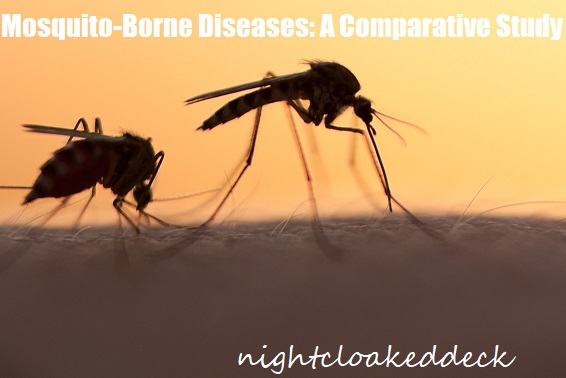
Mosquito-Borne Diseases
Mosquito-borne diseases remain some of the most significant public health challenges worldwide, affecting millions of people each year. These diseases are transmitted by various mosquito species, each carrying distinct pathogens that cause a range of illnesses. This article provides a comparative study of the major mosquito-borne diseases, including malaria, dengue, Zika virus, chikungunya, and West Nile virus, highlighting their transmission mechanisms, symptoms, epidemiology, and control measures.
Malaria
Pathogen and Transmission:
- Causative Agent: Malaria is caused by Plasmodium parasites, with P. falciparum and P. vivax being the most common.
- Vector: Anopheles mosquitoes, primarily Anopheles gambiae and Anopheles funestus, transmit the parasites.
Symptoms:
- High fever, chills, sweats, headache, nausea, vomiting, and muscle pain.
- Severe cases can lead to cerebral malaria, anemia, respiratory distress, and death.
Epidemiology:
- Malaria is endemic in tropical and subtropical regions, especially sub-Saharan Africa, Southeast Asia, and South America.
- It affects approximately 229 million people annually, with over 400,000 deaths, primarily in children under five years old.
Control Measures:
- Insecticide-treated bed nets (ITNs) and indoor residual spraying (IRS).
- Antimalarial medications such as artemisinin-based combination therapies (ACTs).
- Preventive measures like intermittent preventive treatment in pregnancy (IPTp) and seasonal malaria chemoprevention (SMC).
Dengue
Pathogen and Transmission:
- Causative Agent: Dengue virus (DENV), with four serotypes (DENV-1 to DENV-4).
- Vector: Aedes mosquitoes, especially Aedes aegypti and Aedes albopictus.
Symptoms:
- High fever, severe headache, pain behind the eyes, joint and muscle pain, rash, and mild bleeding.
- Severe dengue (dengue hemorrhagic fever) can cause plasma leakage, severe bleeding, and organ impairment.
Epidemiology:
- Dengue is prevalent in tropical and subtropical climates worldwide, including Southeast Asia, the Pacific Islands, Latin America, and Africa.
- An estimated 390 million dengue infections occur annually, with about 96 million manifesting clinically.
Control Measures:
- Vector control through the elimination of breeding sites and use of insecticides.
- Community-based interventions and public health education.
- Dengue vaccine (Dengvaxia) for individuals living in endemic areas with prior dengue infection.
Zika Virus
Pathogen and Transmission:
- Causative Agent: Zika virus (ZIKV), a flavivirus.
- Vector: Aedes mosquitoes, primarily Aedes aegypti.
Symptoms:
- Mild fever, rash, conjunctivitis, muscle and joint pain, headache.
- Zika infection during pregnancy can cause microcephaly and other severe fetal brain defects.
Epidemiology:
- Zika outbreaks have occurred in Africa, Southeast Asia, the Pacific Islands, and the Americas.
- The 2015-2016 outbreak in Brazil brought significant global attention due to its association with congenital Zika syndrome.
Control Measures:
- Vector control through mosquito population reduction and protection from mosquito bites.
- Public health campaigns to raise awareness about Zika transmission and prevention.
- Avoidance of travel to affected areas, especially for pregnant women.
Chikungunya
Pathogen and Transmission:
- Causative Agent: Chikungunya virus (CHIKV), an alphavirus.
- Vector: Aedes mosquitoes, particularly Aedes aegypti and Aedes albopictus.
Symptoms:
- Sudden onset of high fever, severe joint pain (often in the hands and feet), muscle pain, headache, nausea, fatigue, and rash.
- Joint pain can persist for weeks or months, leading to chronic arthritis in some cases.
Epidemiology:
- Chikungunya is endemic in Africa, Asia, the Indian subcontinent, and has spread to the Americas and Europe.
- The virus has caused numerous outbreaks, with millions of cases reported worldwide.
Control Measures:
- Vector control through insecticide use and elimination of breeding sites.
- Community education and personal protective measures, such as using repellents and wearing long sleeves.
- No specific antiviral treatment or vaccine available; management focuses on relieving symptoms.
West Nile Virus
Pathogen and Transmission:
- Causative Agent: West Nile virus (WNV), a flavivirus.
- Vector: Culex mosquitoes, especially Culex pipiens and Culex quinquefasciatus.
Symptoms:
- Most infections are asymptomatic. Mild cases may present with fever, headache, body aches, skin rash, and swollen lymph nodes.
- Severe cases can lead to neurological diseases such as encephalitis, meningitis, and acute flaccid paralysis.
Epidemiology:
- West Nile virus is found in Africa, Europe, the Middle East, North America, and West Asia.
- The virus causes seasonal outbreaks, particularly in North America during the summer and fall.
Control Measures:
- Surveillance and mosquito control programs to reduce mosquito populations.
- Public health campaigns to minimize mosquito exposure.
- Supportive treatment for severe cases; no specific antiviral treatment or vaccine available.
Comparative Analysis
Transmission Dynamics:
- Malaria and West Nile Virus: Transmitted primarily by Anopheles and Culex mosquitoes, respectively, which are active during dusk and dawn.
- Dengue, Zika, and Chikungunya: Spread by Aedes mosquitoes, which are day biters, necessitating different prevention strategies.
Disease Burden:
- Malaria and dengue have the highest global disease burden, with malaria causing the most fatalities.
- Zika, chikungunya, and West Nile virus typically result in fewer deaths but can cause significant morbidity and long-term health effects.
Control Strategies:
- Common measures include vector control, public health education, and surveillance.
- Malaria control also relies heavily on antimalarial drugs and ITNs.
- Vaccination is a developing field, with a dengue vaccine available and others under research.
Public Health Impact:
All these diseases pose significant public health challenges, particularly in resource-limited settings.
Efforts to combat these diseases require coordinated international strategies, substantial funding, and community involvement.
Conclusion
Mosquito-borne diseases, despite their differences in transmission, symptoms, and epidemiology, share common challenges in control and prevention. Innovations in vector control, vaccine development, and public health strategies are essential to mitigate their impact. Continued research and international collaboration are critical to advancing our understanding and ability to combat these pervasive threats effectively.
For More Details NCD!






